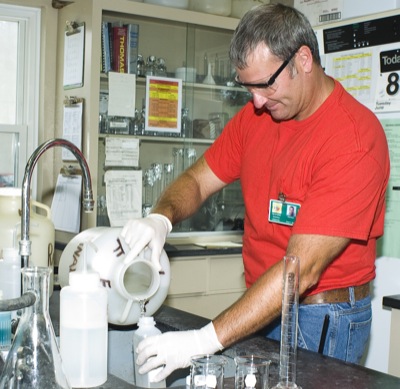Tuesday, June 8th, 2010
EPA adds mandate to water treatment
New rules to increase Celina's expenses
By William Kincaid

Photo by Mark Pummell/The Daily Standard
Celina city employee Scott Conn draws a water sample for testing this morning at the city's wastewater treatment plant.
CELINA - New Ohio EPA phosphorus regulations for Celina's wastewater plant will cost the city thousands of dollars in construction and chemical costs, according to city officials.
Council members at a recent committee meeting discussed the forthcoming changes that will affect operations at the treatment plant.
"Basically, the Ohio EPA has mandated that the city of Celina, as well as most cities our size, remove phosphorus from our effluent (discharge)," said Kerry Duncan, Celina's wastewater treatment plant superintendent.
The city's treated wastewater discharges into Beaver Creek.
Currently, there are no limits regarding phosphorus discharge, according to Duncan. The EPA will require a maximum discharge of 1 mg of phosphorus per liter.
"It varies quite a bit," Duncan said about current phosphorus ranges, estimating it's about 2 to 3 mg per liter a day. The plant releases 2.5 million gallons of water a day, Duncan said.
The new phosphorus requirement for Celina was set by the EPA when it applied for its most recent treatment permit renewal, according to Celina Planning and Community Development Director Kent Bryan. The five-year permit was renewed in February 2007, according to a spokesperson at the Ohio EPA.
Bryan said the Ohio EPA completed a water test of the Beaver Creek a few years backs. To improve the creek's water conditions, they set the new mandate for Celina to reduce its phosphorus level.
In order to comply, new chemicals will have to be added to the water before discharge. Duncan said he does not know how much the additional chemicals will cost each month.
Also, Celina will have to construct a small building for chemical feed pumps and tanks, Duncan said. He was reluctant to estimate the construction total, including a monitoring system, but said it would probably cost about $75,000.
The EPA's construction deadline - when any plant additions must be completed - is June 1, 2011.
Phosphorus discharge levels must be compliant with the new standards by Dec. 1, 2011, Duncan said.
Dave Sprague, superintendent of St. Mary's water and sewer departments, said St. Marys has been required to meet a phosphorus discharge level of 1 mg per litter for many years because the city's water eventually flows to Lake Erie.
"We've been under those rules since the mid '80s," he said.
St. Mary's new $11 million wastewater treatment plant was completed and online May 5, 2009.
"We use a combination of biological and chemical treatment," Sprague said about removing phosphorus.
Biological treatment includes creating the right kind of environment to enable microorganisms to "tie up phosphorus in the cell structure," Sprague said.
The microorganisms and phosphorus later settle and are removed, he said.


